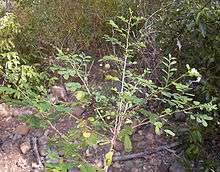Sauropus
The genus Sauropus, of the family Phyllanthaceae, comprises about 40 species of herbs, shrubs or subshrubs, sometimes with woody bases. These plants can be monoecious or dioecious. They are distributed in Southeast Asia, Malesia and Australia.
| Sauropus | |
|---|---|
 | |
| Sauropus albiflorus | |
 | |
| Sauropus arenosus | |
| Scientific classification | |
| Kingdom: | Plantae |
| Clade: | Tracheophytes |
| Clade: | Angiosperms |
| Clade: | Eudicots |
| Clade: | Rosids |
| Order: | Malpighiales |
| Family: | Phyllanthaceae |
| Subfamily: | Phyllanthoideae |
| Tribe: | Phyllantheae |
| Genus: | Sauropus Blume |
| Species | |
|
About 40; see text | |
| Synonyms[1] | |
Taxonomy
In a 2006 revision of the Phyllanthaceae, it was recommended that Sauropus be subsumed in Phyllanthus; however, new combinations in Phyllanthus for former Sauropus species remain to be published.[2]
Description
Sauropus species have alternate, entire leaves with short petioles and small stipules. Flowers appear at axils and mainly form clusters. There are 6 perianth segments divided in 2 whorls, with female flowers often having bigger perianths. At male flowers, the perianth is tube-like, with 3 stamen. The fruit is berry-like, ovoid or globose, and fleshy.
Species include
- Sauropus albiflorus
- Sauropus amabilis
- Sauropus amoebiflorous
- Sauropus androgynus - star gooseberry, katuk
- Sauropus arenosus
- Sauropus assimilis
- Sauropus asteranthos
- Sauropus bacciformis
- Sauropus bicolor
- Sauropus brevipes
- Sauropus brunonis
- Sauropus convollerioides
- Sauropus crassifolius
- Sauropus discocalyx
- Sauropus ditassoides
- Sauropus garrettii
- Sauropus glaucus
- Sauropus gracilis
- Sauropus granulosus
- Sauropus heteroblastus
- Sauropus hirsutus
- Sauropus hirtellus
- Sauropus kerrii
- Sauropus macranthus
- Sauropus ochrophyllus
- Sauropus orbicularis
- Sauropus pauciflorus
- Sauropus poomae
- Sauropus pulchellus
- Sauropus quadrangularis
- Sauropus ramosissimus
- Sauropus rimaphilus
- Sauropus rhamnoides
- Sauropus rhytidospermus
- Sauropus rigens
- Sauropus rostatus
- Sauropus similis
- Sauropus spatulifolius
- Sauropus suberosus
- Sauropus subterblancus
- Sauropus thorelii
- Sauropus thyrsiflorus
- Sauropus trachyspermus
- Sauropus villosus
Formerly placed here
Sauropus elegantissimus has become Breynia retusa.
References
| Wikimedia Commons has media related to Sauropus. |
- "World Checklist of Selected Plant Families".
- Hoffmann, Petra; Kathriarachchi, Hashendra S.; Wurdack, Kenneth J. (2006). "A Phylogenetic Classification of Phyllanthaceae". Kew Bulletin. 61 (1): 37–53.